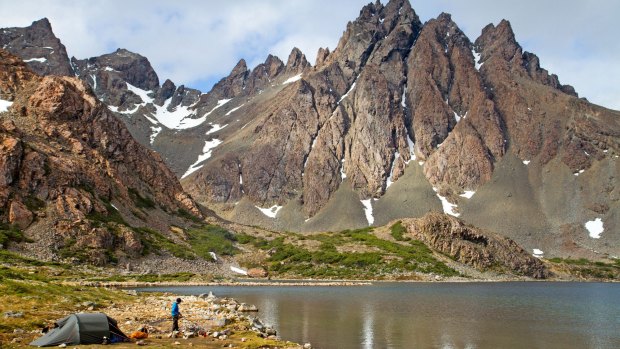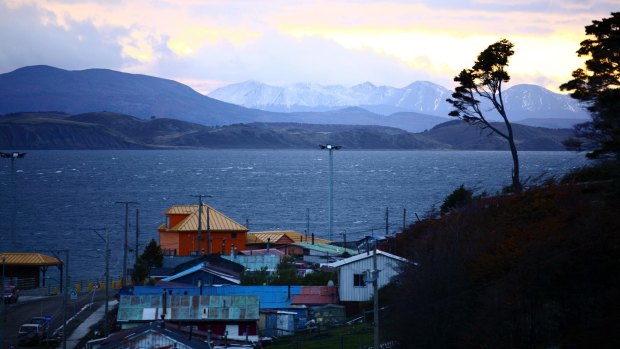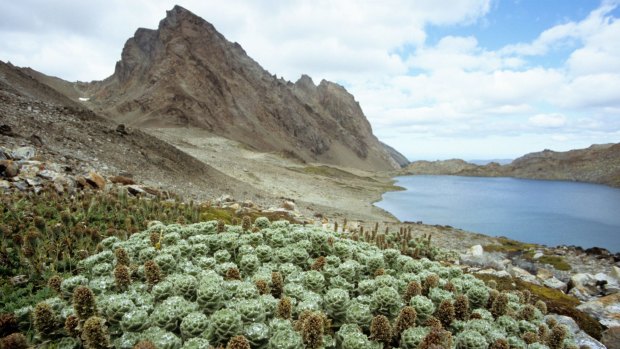This was published 5 years ago
Dientes Circuit, Chile trekking: The world's biggest little mountains
By Andrew Bain

Laguna de los Dientes at the foot of the Dientes de Navarino mountains.Credit: Andrew Bain
It's as though the numbers lie. The raw, rocky mountains of the Dientes de Navarino tower above me, their sharp tips seeming to scratch at the sky. A lake lies frozen far below me deep into summer, and snow continues to fall for a second day.
I feel as though I could be standing 4000 metres up in any of the world's great mountain ranges, and yet I'm just a few hundred metres above sea level on Chile's Navarino Island, and not one of these peaks around me exceeds 1200 metres. They might be the biggest little mountains in the world.
Looping through this serrated line of peaks is the Dientes Circuit, a trail billed as the southernmost trek in the world. Setting out from near Puerto Williams, the world's most southerly town, the trek crosses the 55th parallel (13 degrees further south than Hobart) as it journeys through the Dientes de Navarino.

The trek begins in deep beech forest at the end of a ridge overlooking Puerto Williams and, distantly, the Argentine city of Ushuaia across the Beagle Channel. Credit: Alamy
But this trek's beauty is about more than geographic boasting rights. Lonely Planet has called it the best trek in South America, and the mountains are every bit as rugged and impressive as their bigger-name, larger-sized counterparts elsewhere on the continent.
"Two years ago, half a million people trekked in Torres del Paine," says local trekking guide Celio Lebailly. "Two years ago, only 400 people trekked the Dientes Circuit, and yet this is much more wild."
By those standards, it's a busy day on the Dientes Circuit as I set out walking with Celio, with four days and around 50 kilometres rolled out ahead of us. It's the day after the weekly ferry has docked in Puerto Williams after its 30-hour journey from Punta Arenas, which always leads to "crowds" on the trek - this day, five other people are setting out.

The dramatic pinnacles of the highest of the Dientes massif. Credit: Alamy
The trek begins in deep beech forest at the end of a ridge overlooking Puerto Williams and, distantly, the Argentine city of Ushuaia across the Beagle Channel. The ground is dotted with white orchids, and we graze on wild berries as we climb, although we're a few weeks too early for the wild strawberries that grow across the slopes.
Little more than an hour from beginning, we rise out of the forest and onto the first summit along the ridge - Cerro Bandera, or Flag Mountain, named for the large Chilean flag that's flown here since the 1980s when it was hoisted during tensions with Argentina, which lies just five kilometres across the channel. Each year on Chile's national day, the flag is replaced. Less than three months on, it's already tattered and torn by the ferocious Patagonian conditions.
The way ahead is along the ridge, cutting across a steep, loose and, at times, precarious scree slope. Beech trees grow prostrate, stunted and pruned by the wind, and soon ice and snow are spitting in our faces as clouds skate across the sky. Five minutes later, we're aglow with tepid sunshine again.
"The weather they might get in a year in Europe, you get in one day here," Celio says. "You'll never be bored by the weather."
This first day we're hiking to Laguna del Salto, one of a multitude of lakes that form a necklace around the range. From here the mountains feel suitably named - the Dientes de Navarino, or Teeth of Navarino, with sharp peaks rising like fangs.
Standing on the shore of Laguna del Salto, I can't shake a feeling of disbelief. These mountains appear as rugged as anything in the world, and yet they're no higher than the Blue Mountains or Hobart's Mt Wellington.
There are no huts anywhere along the Dientes Circuit - the only bit of infrastructure is three wooden lookout platforms - and we pitch camp this night on a stony plateau atop bluffs that rise from the lake. By now the snow has set in, smothering the mountains and our tent. Gusts of wind assault the tent, but by morning all is still, even as light snow continues to fall.
This second day will be spent in the intimate company of mountains as we rise up rocky slopes, our steps muffled by the snow, and cut beneath the two "teeth" that have been dominating the view for hours. In quick succession we cross two passes, including the comfortingly named Paso Australia, coming to a breach in the mountains that marks one of the trek's truly revelatory moments.
On one side, a large lake lies grey and frozen, while on the other is an open lake so blue and clear it almost invites a swim ... or at least it would if the air temperature wasn't a miserly six degrees. Rising from the shore of this lake is Picacho Diente de Navarino, the island's highest mountain.
But the part of the view that impresses most - at least in the mind - is also the most distant. Beyond Navarino's flat south coast rise the hazy islands of the Cape Horn archipelago, where South America ends and notoriously wild oceans begin. It's a spot as near to the end of the world as we know, and it's little more than 100 kilometres away.
This night's camp is now just a short walk away, on the gorgeous shores of Laguna de los Dientes. We have walked around eight kilometres and yet we camp little more than two straight-line kilometres from our previous night, on the opposite side of the range. The snow has melted away, and as day drags into long evening - sunset here is after 10pm in summer - the mountains glow like embers.
We wake the next morning to a perfect blue day and winds that roar down the valley. This is how I remember Patagonia from previous visits - the raw, rasping winds that have played such a role in shaping this most extraordinary and abstract of landscapes.
Native quails skitter about the trail, and the mountain walls are bent and twisted by forces even more cataclysmic than the winds.
We seem to ascend the next pass less by waking than by the whim of the wind. By the time we crest the pass, it's blowing in excess of 100kmh, and standing still is a game that I lose.
From here, the circuit follows a chain of lakes across the foot of the Lindenmayer Range. Every lakeshore is scarred by beaver activity, the North American animals introduced so destructively to Navarino Island in the 19th century for their pelts. Hiking among the ravaged valley's dead, bleached trees is like walking through an elephant graveyard.
Our last day brings a final mountain pass and the longest and steepest of the Dientes Circuit's climbs. The day breaks overcast but hushed, as though the world blew itself into exhaustion the previous day. The only sounds are the Guerrico River hurrying past our tent and the crackle of our campfire as we cook our breakfast fajitas.
We follow the valley through peaty meadows and past myriad beaver dams before turning up the slopes towards Paso Virginia. The climb heads first through a mire of mud inside the lenga forest and then onto wind-chilled alpine slopes, with Ushuaia coming back into view across the channel.
Paso Victoria is a broad pass - around 1.5 kilometres wide - covered in shattered red rock so that it feels as though I could be walking on the surface of Mars. At its end it falls away into oblivion, plunging hundreds of metres to the barren shores of Laguna los Guanacos. A few steps away, the last glacier on Navarino Island clings to the mountains like a barnacle.
The sense of exposure and elevation is immense, and once again I feel as though I'm thousands of metres up in a grand and celebrated mountain range. Yet I'm almost at the ocean edge, barely 1000 metres above sea level, living it large on very small mountains.
TRIP NOTES
MORE
FLY
LATAM flies direct from Sydney and Melbourne to Santiago, Chile's capital, with connections to Punta Arenas in the south of the country. Aerovias DAP flies from Punta Arenas to Puerto Williams, the only town on Navarino Island. latam.com; dapairline.com
TREK
Turismo Shila runs four-day, three-night Dientes Circuit guided treks, starting and finishing in Puerto Williams. Trips cost around $1700, including all meals. turismoshila.cl
STAY
Just two kilometres from Puerto Williams', Lakutaia Lodge provides a warm and quiet stay overlooking a narrow arm of the Beagle Channel. Meals are excellent and free bikes are on hand for rides into town. lakutaia.com/en
Andrew Bain travelled courtesy of Chile Tourism.
FIVE OTHER GREAT SOUTH AMERICAN ISLANDS
EASTER ISLAND (CHILE)
Considered one of the world's most remote islands, Easter Island sits around 3500 kilometres off the coast of South America and is famed for its stone moai statues - almost 1000 of them.
GALAPAGOS ISLANDS (ECUADOR)
Wander and swim among docile critters in the wildlife wonderland that helped shape Charles Darwin's theory of evolution.
ROBINSON CRUSOE ISLAND (CHILE)
The island that inspired its namesake book sits 650 kilometres off the coast of central Chile. As the name suggests, it's a place to really escape the world.
FERNANDO DE NORONHA (BRAZIL)
Beach bliss on this archipelago of 21 islands said to have the planet's highest concentration of resident dolphins.
SAN ANDRES (COLOMBIA)
Welcome to the true Pirates of the Caribbean, with stolen treasure rumoured to still be hidden in the caves of this diving paradise that's located closer to Nicaragua than Colombia.
Sign up for the Traveller Deals newsletter
Get exclusive travel deals delivered straight to your inbox. Sign up now.